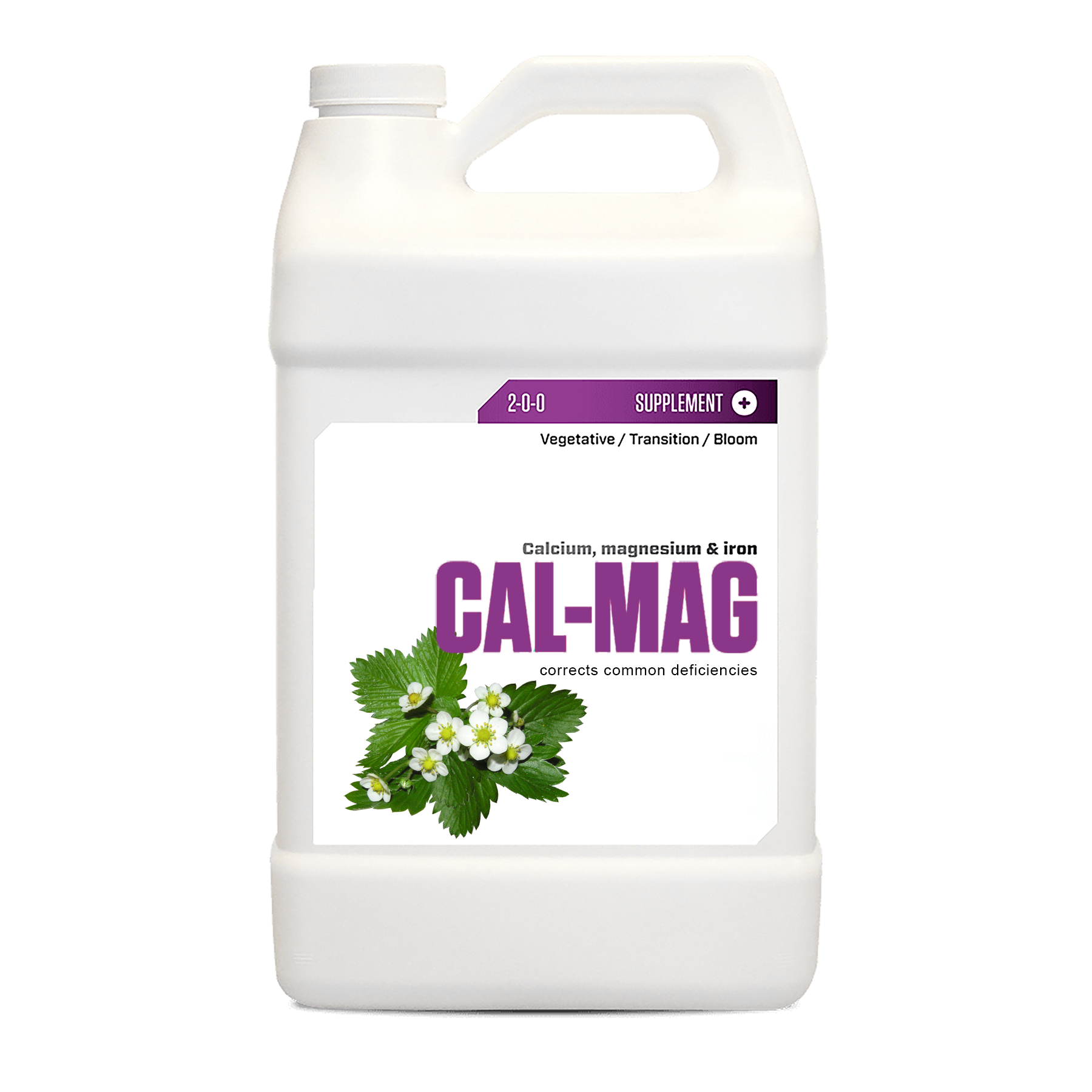Hit it with Cal-Mag!

Hey Folks! I was lurking in the Cannabis Cultivation subreddit earlier this week and saw a couple of posts where someone (the OP) was looking for advice from the community about a visual issue with their plants. In both cases the consensus from the community was that it was a magnesium issue and OP just needed to give it some Cal-Mag and it would perk right up. The responses made me chuckle, not because the commenters are wrong, but because it completely matches up with stories my colleague Sam tells me about his experiences working as a commercial cannabis cultivator. Since we’re focusing on magnesium this month in our posts I thought that this was the perfect opportunity to get Sam’s thoughts on all things Cal-Mag. This is what he had to say.
Thoughts About Cal-Mag
“I love Cal-Mag and I think that it is a great product in the right circumstance. However, the pervasive reliance on Cal-Mag as a magic fix-all for all cannabis-related maladies has evolved into a running joke within the cultivation community.
Is a plant looking slightly lackluster? Spray it with Cal-Mag. Are the leaves looking a little yellow? It needs some Cal-Mag. Not sure what’s going on? Just give it some Cal-Mag! This knee-jerk reaction to saturate it with a Cal-Mag foliar spray is a practice many growers, myself included, have engaged in at some point in their careers. I’ve lost count of the number of times I’ve walked into a room and said, “F*CK IT, hit it with Cal-Mag” It’s a quick fix that seems to work like magic, prompting the plants to regain their vibrancy and vitality. Yet, the danger lies in the deceptive allure of vibrant, green foliage. Behind this façade, a more insidious problem may linger, masked by the superficial improvement in plant appearance.. Yes, hitting the plants with a dose of Cal-Mag may cause them to look better, but are they actually better? Or did the Cal-Mag just give you a false sense of security?
Cal-Mag As a Tool, Not a Fix-All
The irony is that relying solely on visual cues to diagnose and rectify nutrient deficiencies or excesses is akin to wielding a double-edged sword. The intricacies of cannabis nutrition reveal a sobering reality – issues related to nutrient imbalances or deficiencies often incubate beneath the surface for extended periods. Interestingly, it can take anywhere from 4 to 9 weeks for nutritional problems to become evident through visible leaf symptoms. There are instances where a timely Cal-Mag application addresses the immediate issue, but it’s important to understand why. Cal-Mag is a tool and when used properly will help your plants achieve their maximum potential, but it’s not a fix-all.
Many of the most commonly used Cal-Mag formulations incorporate calcium and magnesium nitrate, which contain substantial amounts of nitrate nitrogen. This means that for every unit of calcium, two nitrates are introduced. Consequently, this may lead to an excess of nitrate, resulting in an aesthetically pleasing dark green color, but potentially overloading the plant. The issues with excessive levels of magnesium have already been covered here. Just to expand on that post with my own thoughts, excessive levels of calcium (Ca) and magnesium (Mg) in cannabis plants pose various risks such as,
- Nutrient imbalances that hinder the uptake of essential elements, potentially leading to deficiencies.
- Nutrient toxicity, causing symptoms like leaf burn and necrosis.
- An overabundance of Ca and Mg can disrupt the pH levels of the growing medium, affecting nutrient availability.
- The accumulation of excess minerals may reduce water uptake, leading to dehydration and stress.
- Elevated Ca and Ma levels may compromise the quality of cannabis flowers, impacting cannabinoid and terpene production.
When Should I Use Cal-Mag?
So clearly Cal-Mag shouldn’t be used in every situation because there can be real unintended consequences, and without knowing for sure what the nutrient issue with the plant actually is it may also just be a waste of money. So when should you use extra Cal-Mag? That question is why plant nutrient analysis is so important. Nutrient analysis of leaf tissue helps you know exactly what your plant’s nutrient levels are so that you know what your plants need.
Incorporating Nutrient Analysis of Leaf Tissue
Ultimately the advent of mainstream acceptance of cannabis cultivation has brought with it a wealth of new technologies and information previously inaccessible during our traditional market days. As our understanding deepens, the pitfalls of relying solely on quick-fix solutions like Cal-Mag become apparent. It should prompt us to reevaluate our approach, recognizing that comprehensive and proactive nutrient management, guided by emerging technologies and informed practices, is essential for sustaining both yield and quality in the burgeoning realm of contemporary cannabis cultivation.
Testing with Arvum Plant Labs
Want to stop guessing about what’s going on with your plants and know for sure? Arvum offers a free round of testing to all new customers as a way to demonstrate the power of plant nutrient analysis.
It’s better to know for sure! Call us at 707-398-8346 to receive your free round of plant nutrient analysis and get objective data about your plants’ nutrient levels!







